Abstract
Three negative reinforcement experiments employing a key-peck response are described. In Experiment I, pigeons shocked on the average of twice per minute (imposed condition) could produce, by pecking a key, an alternate condition with correlated stimuli. Delayed shocks were added, across sessions, to the alternate condition until pecking stopped. Two of three pigeons continued to peck despite a 100% increase in shock frequency. In Experiment II, pigeons were shocked in the imposed condition four times per minute. The postresponse delay to shock was held constant by delivering, in the alternate condition, the next shock, or the next two, three, or four shocks from the imposed-condition shock schedule. All three subjects continued to peck with no change in delay to the first two postresponse shocks but with a 75% reduction in shock frequency. In Experiment III, a response produced an immediate shock followed by a shock-free period. Three of four subjects continued to respond despite reduced delay to shock. Delay-to-shock or shock-frequency reduction was sufficient to maintain key pecking, but neither was necessary. The conditions that negatively reinforce the pigeon's key peck were similar to conditions that negatively reinforce the rat's bar press.
Keywords: aversive control, avoidance, delayed shock, shock frequency, key pecking, pigeons
Full text
PDF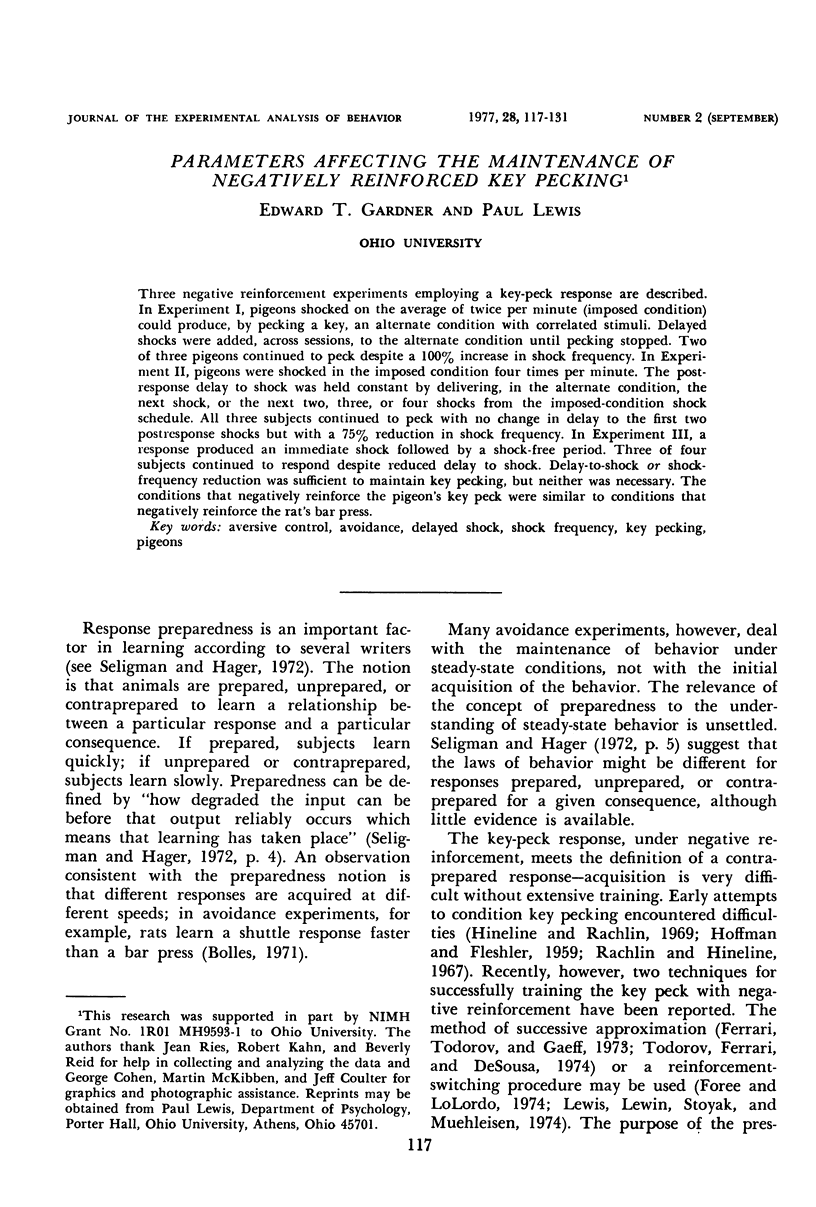
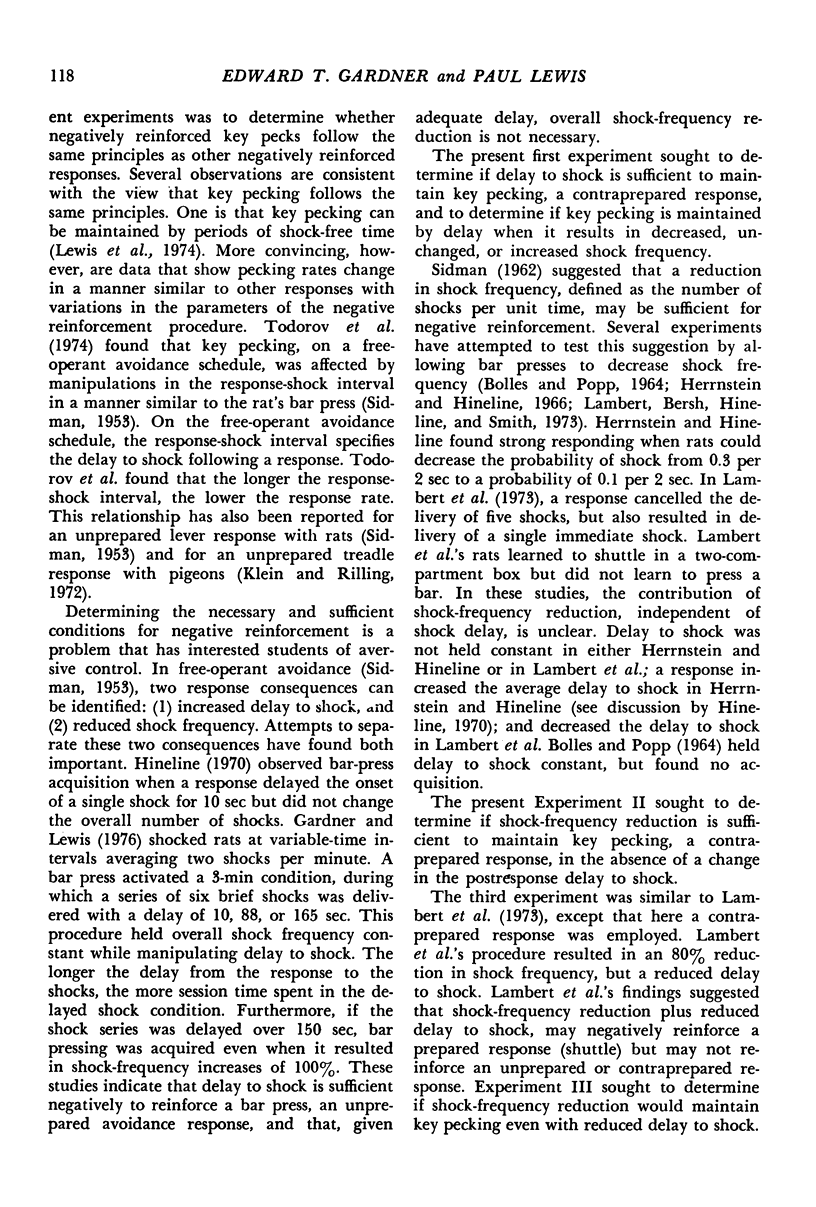
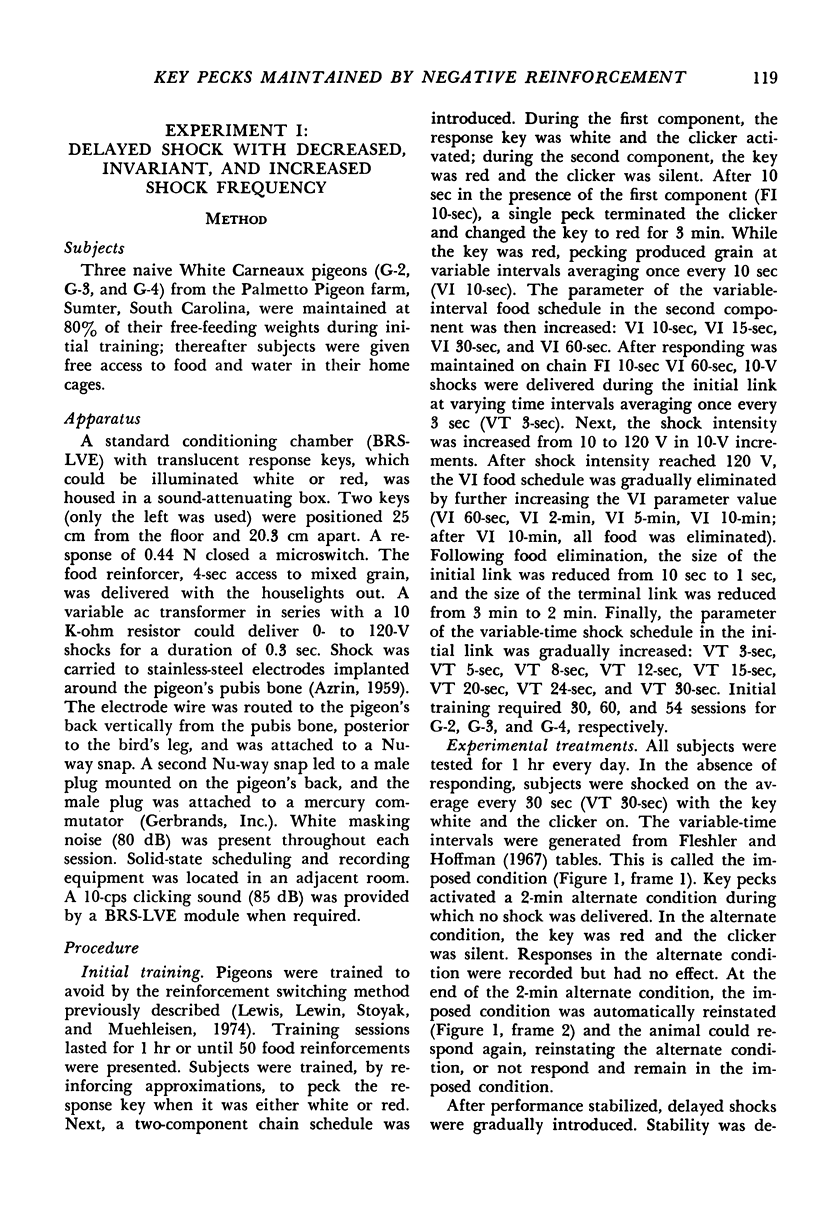
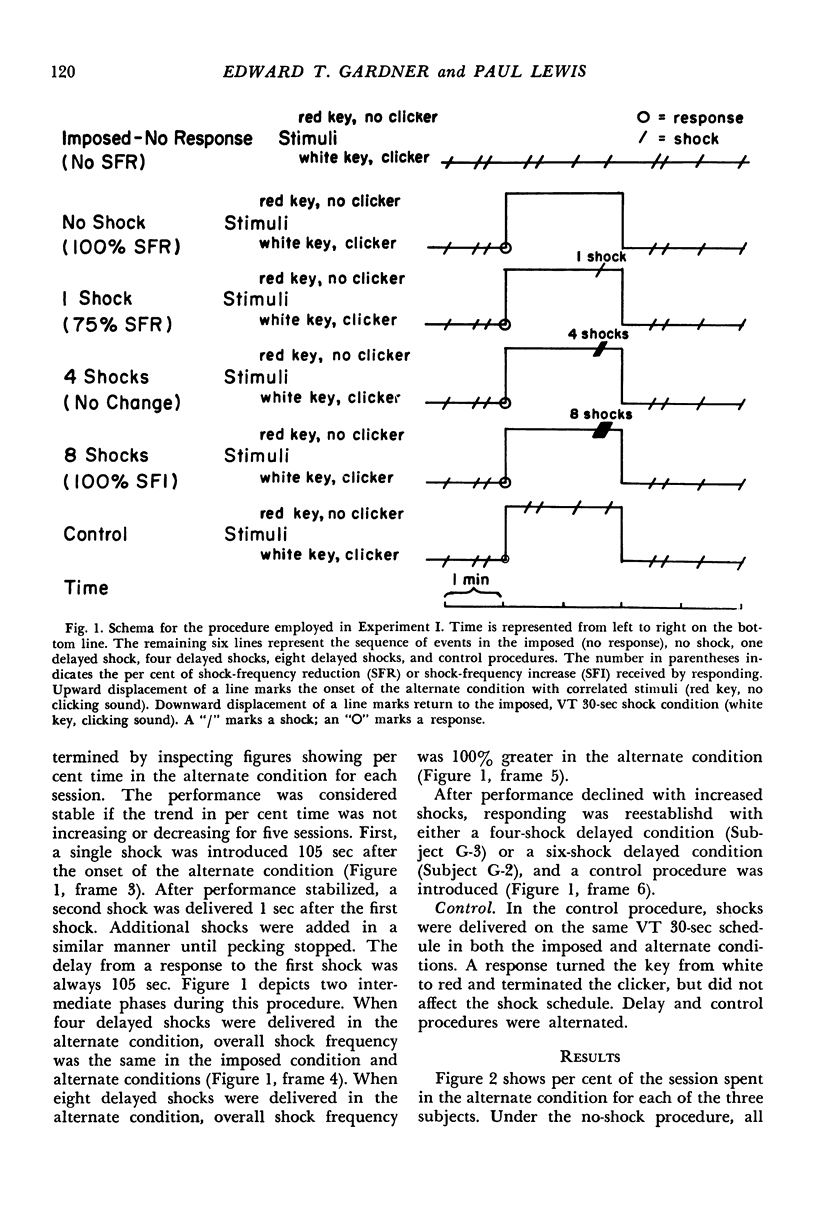
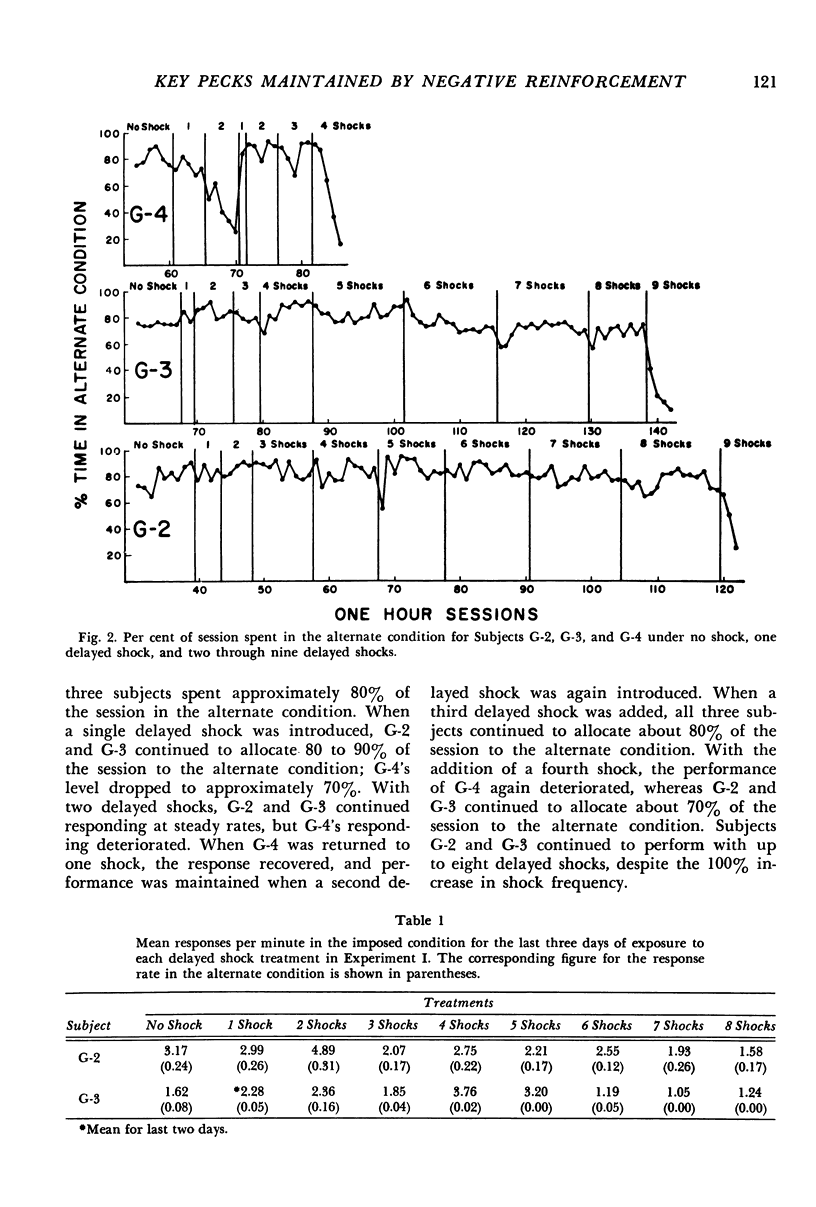
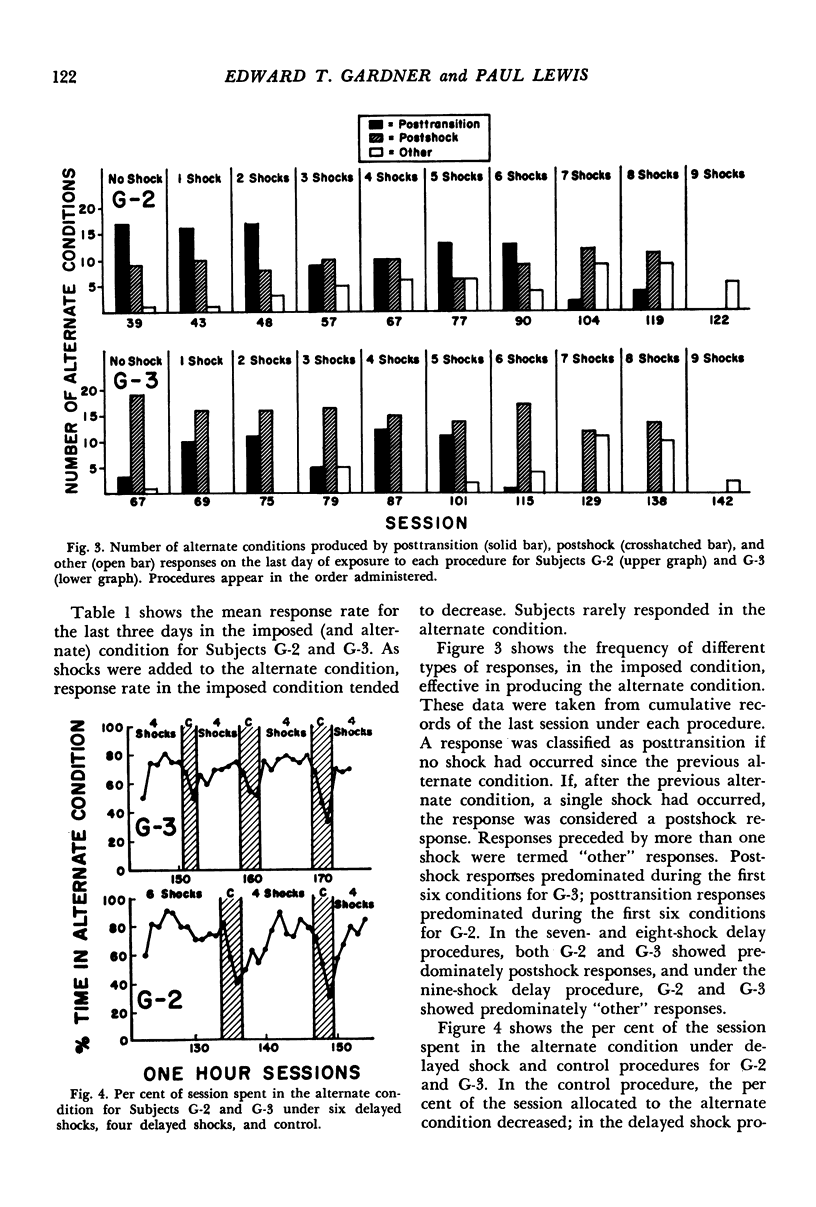

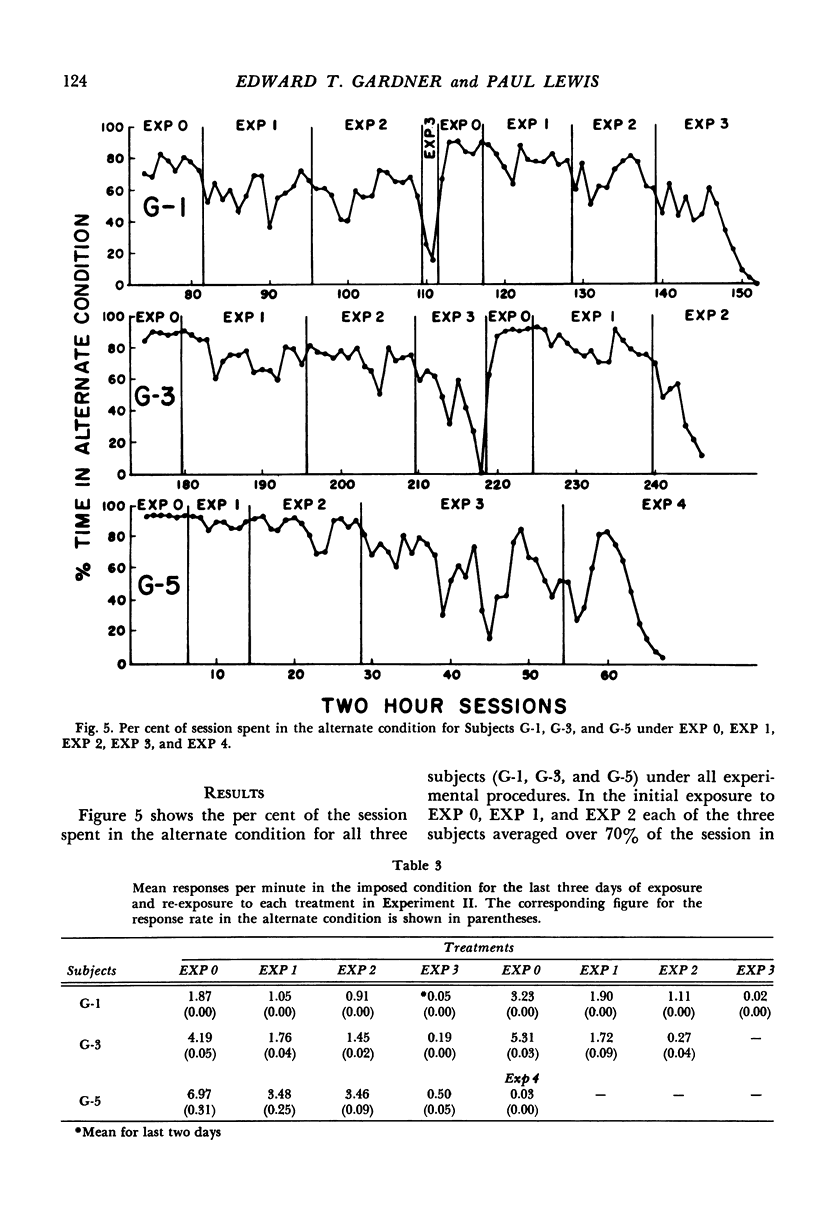


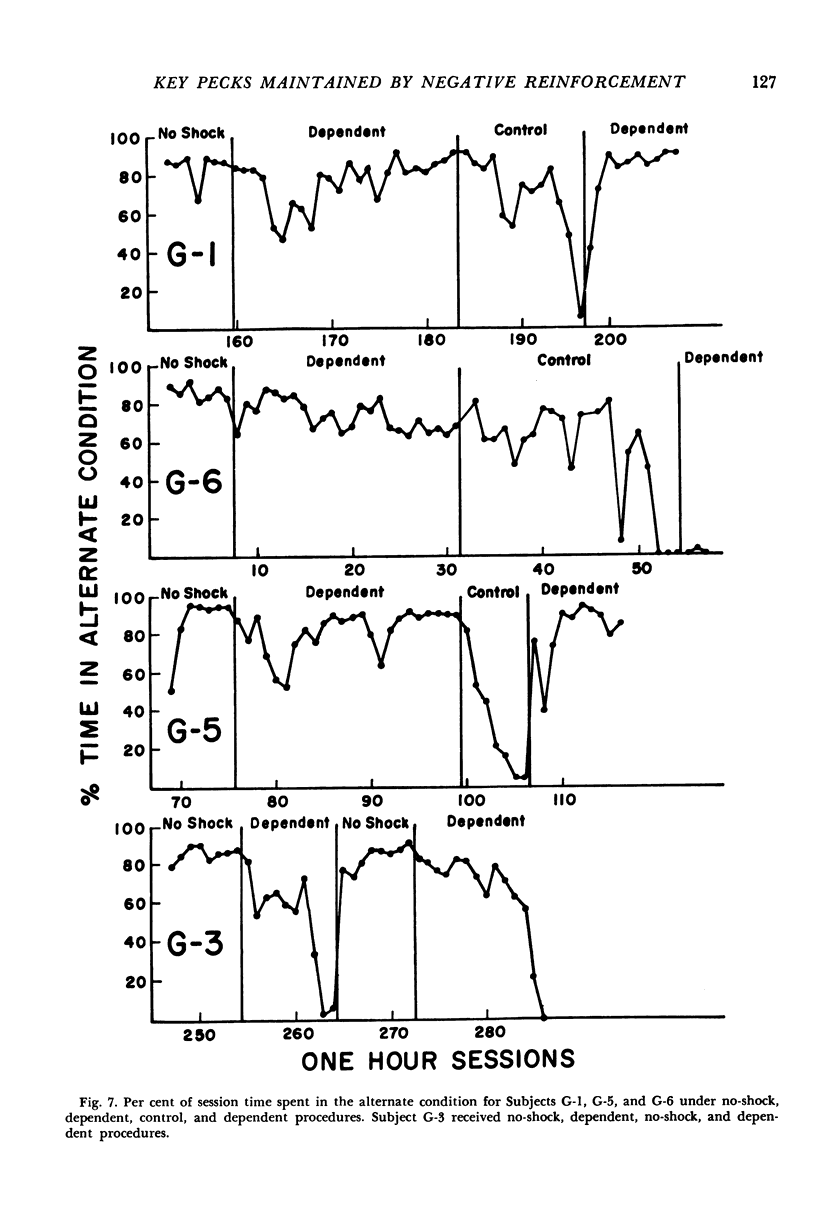
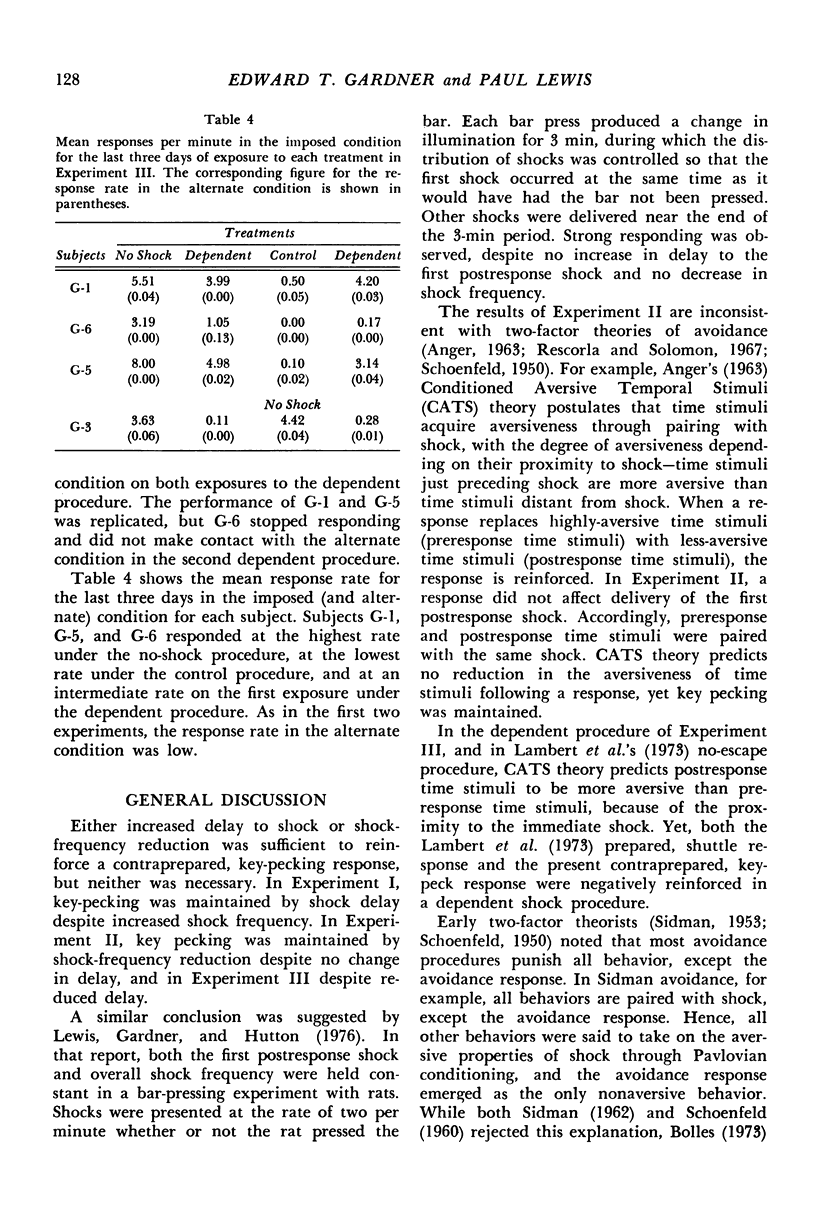
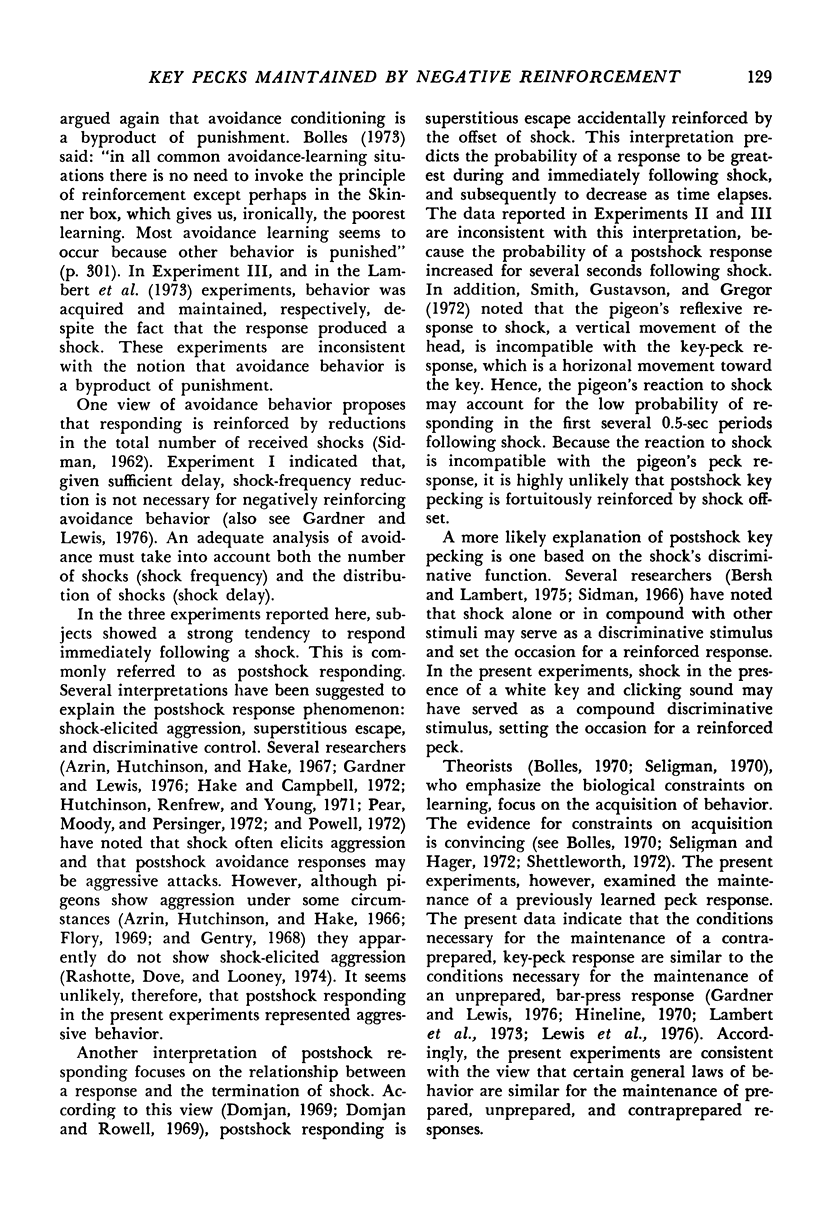
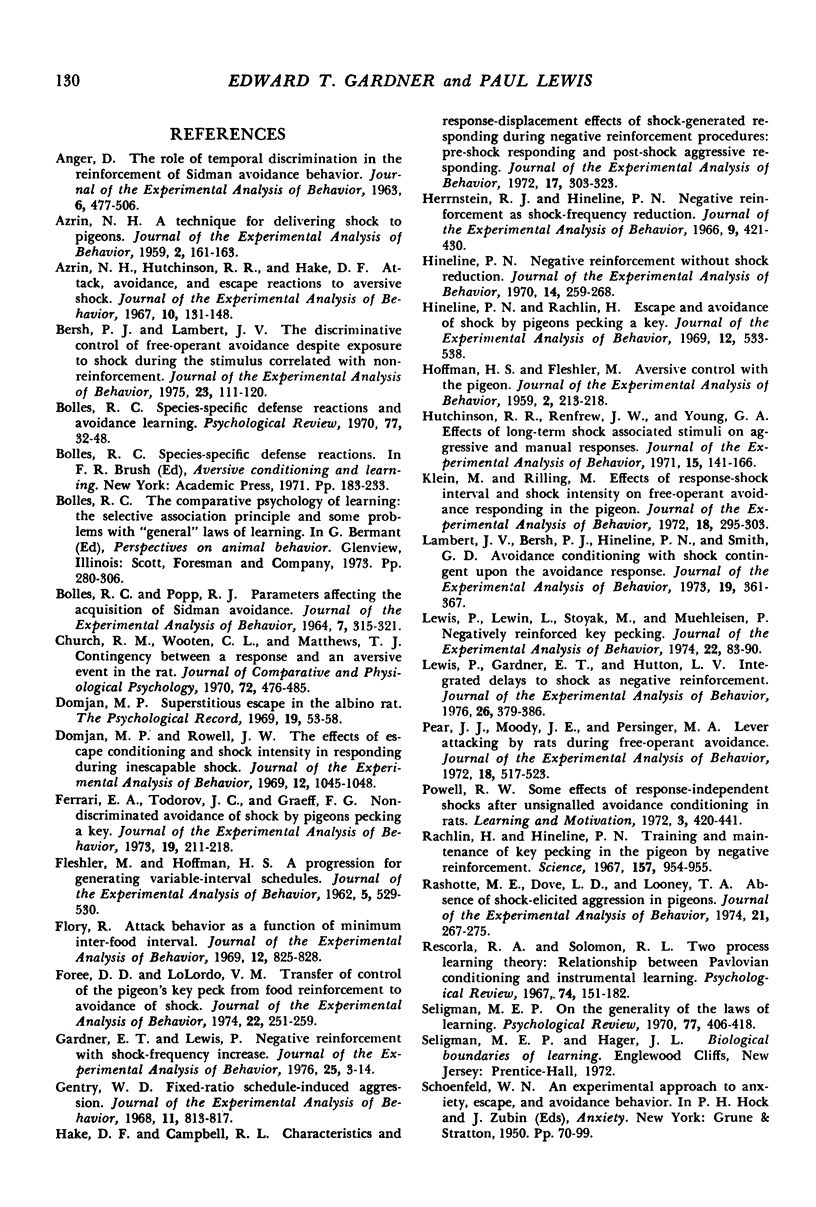

Selected References
These references are in PubMed. This may not be the complete list of references from this article.
- ANGER D. The role of temporal discriminations in the reinforcement of Sidman avoidance behavior. J Exp Anal Behav. 1963 Jul;6(3):477–506. doi: 10.1901/jeab.1963.6-s477. [DOI] [PMC free article] [PubMed] [Google Scholar]
- AZRIN N. H. A technique for delivering shock to pigeons. J Exp Anal Behav. 1959 Apr;2:161–163. doi: 10.1901/jeab.1959.2-161. [DOI] [PMC free article] [PubMed] [Google Scholar]
- Azrin N. H., Hutchinson R. R., Hake D. F. Attack, avoidance, and escape reactions to aversive shock. J Exp Anal Behav. 1967 Mar;10(2):131–148. doi: 10.1901/jeab.1967.10-131. [DOI] [PMC free article] [PubMed] [Google Scholar]
- BOLLES R. C., POPP R. J., Jr PARAMETERS AFFECTING THE ACQUISITION OF SIDMAN AVOIDANCE. J Exp Anal Behav. 1964 Jul;7:315–321. doi: 10.1901/jeab.1964.7-315. [DOI] [PMC free article] [PubMed] [Google Scholar]
- Bersh P. J., Lambert J. V. The discriminative control of free-operant avoidance despite exposure to shock during the stimulus correlated with nonreinforcement. J Exp Anal Behav. 1975 Jan;23(1):111–120. doi: 10.1901/jeab.1975.23-111. [DOI] [PMC free article] [PubMed] [Google Scholar]
- Domjan M. P., Rowell J. W. The effects of escape conditioning and shock intensity on responding during inescapable shock. J Exp Anal Behav. 1969 Nov;12(6):1045–1048. doi: 10.1901/jeab.1969.12-1045. [DOI] [PMC free article] [PubMed] [Google Scholar]
- FLESHLER M., HOFFMAN H. S. A progression for generating variable-interval schedules. J Exp Anal Behav. 1962 Oct;5:529–530. doi: 10.1901/jeab.1962.5-529. [DOI] [PMC free article] [PubMed] [Google Scholar]
- Ferrari E. A., Todorov J. C., Graeff F. G. Nondiscriminated avoidance of shock by pigeons pecking a key. J Exp Anal Behav. 1973 Mar;19(2):211–218. doi: 10.1901/jeab.1973.19-211. [DOI] [PMC free article] [PubMed] [Google Scholar]
- Flory R. Attack behavior as a function of minimum inter-food interval. J Exp Anal Behav. 1969 Sep;12(5):825–828. doi: 10.1901/jeab.1969.12-825. [DOI] [PMC free article] [PubMed] [Google Scholar]
- Foree D. D., Lolordo V. M. Transfer of control of the pigeon's key peck from food reinforcement to avoidance of shock. J Exp Anal Behav. 1974 Sep;22(2):251–259. doi: 10.1901/jeab.1974.22-251. [DOI] [PMC free article] [PubMed] [Google Scholar]
- Gardner E. T., Lewis P. Negative reinforcement with shock-frequency increase. J Exp Anal Behav. 1976 Jan;25(1):3–14. doi: 10.1901/jeab.1976.25-3. [DOI] [PMC free article] [PubMed] [Google Scholar]
- Gentry W. D. Fixed-ratio schedule-induced aggression. J Exp Anal Behav. 1968 Nov;11(6):813–817. doi: 10.1901/jeab.1968.11-813. [DOI] [PMC free article] [PubMed] [Google Scholar]
- HOFFMAN H. S., FLESHLER M. Aversive control with the pigeon. J Exp Anal Behav. 1959 Jul;2:213–218. doi: 10.1901/jeab.1959.2-213. [DOI] [PMC free article] [PubMed] [Google Scholar]
- Hake D. F., Campbell R. L. Characteristics and response-displacement effects of shock-generated responding during negative reinforcement procedures: pre-shock responding and post-shock aggressive responding. J Exp Anal Behav. 1972 May;17(3):303–323. doi: 10.1901/jeab.1972.17-303. [DOI] [PMC free article] [PubMed] [Google Scholar]
- Herrnstein R. J., Hineline P. N. Negative reinforcement as shock-frequency reduction. J Exp Anal Behav. 1966 Jul;9(4):421–430. doi: 10.1901/jeab.1966.9-421. [DOI] [PMC free article] [PubMed] [Google Scholar]
- Hineline P. N. Negative reinforcement without shock reduction. J Exp Anal Behav. 1970 Nov;14(3):259–268. doi: 10.1901/jeab.1970.14-259. [DOI] [PMC free article] [PubMed] [Google Scholar]
- Hineline P. N., Rachlin H. Escape and avoidance of shock by pigeons pecking a key. J Exp Anal Behav. 1969 Jul;12(4):533–538. doi: 10.1901/jeab.1969.12-533. [DOI] [PMC free article] [PubMed] [Google Scholar]
- Hutchinson R. R., Renfrew J. W., Young G. A. Effects of long-term shock and associated stimuli on aggressive and manual responses. J Exp Anal Behav. 1971 Mar;15(2):141–166. doi: 10.1901/jeab.1971.15-141. [DOI] [PMC free article] [PubMed] [Google Scholar]
- Klein M., Rilling M. Effects of response-shock interval and shock intensity on free-operant avoidance responding in the pigeon. J Exp Anal Behav. 1972 Sep;18(2):295–303. doi: 10.1901/jeab.1972.18-295. [DOI] [PMC free article] [PubMed] [Google Scholar]
- Lambert J. V., Bersh P. J., Hineline P. N., Smith G. D. Avoidance conditioning with shock contingent upon the avoidance response. J Exp Anal Behav. 1973 Mar;19(2):361–367. doi: 10.1901/jeab.1973.19-361. [DOI] [PMC free article] [PubMed] [Google Scholar]
- Lewis P., Gardner E. T., Hutton L. Integrated delays to shock as negative reinforcement. J Exp Anal Behav. 1976 Nov;26(3):379–386. doi: 10.1901/jeab.1976.26-379. [DOI] [PMC free article] [PubMed] [Google Scholar]
- Lewis P., Lewin L., Stoyak M., Muehleisen P. Negatively reinforced key pecking. J Exp Anal Behav. 1974 Jul;22(1):83–90. doi: 10.1901/jeab.1974.22-83. [DOI] [PMC free article] [PubMed] [Google Scholar]
- Pear J. J., Moody J. E., Persinger M. A. Lever attacking by rats during free-operant avoidance. J Exp Anal Behav. 1972 Nov;18(3):517–523. doi: 10.1901/jeab.1972.18-517. [DOI] [PMC free article] [PubMed] [Google Scholar]
- Rachlin H., Hineline P. N. Training and maintenance of keypecking in the pigeon by negative reinforcement. Science. 1967 Aug 25;157(3791):954–955. doi: 10.1126/science.157.3791.954. [DOI] [PubMed] [Google Scholar]
- Rashotte M. E., Dove L. D., Looney T. A. Absence of shock-elicited aggression in pigeons. J Exp Anal Behav. 1974 Mar;21(2):267–275. doi: 10.1901/jeab.1974.21-267. [DOI] [PMC free article] [PubMed] [Google Scholar]
- Rescorla R. A., Solomon R. L. Two-process learning theory: Relationships between Pavlovian conditioning and instrumental learning. Psychol Rev. 1967 May;74(3):151–182. doi: 10.1037/h0024475. [DOI] [PubMed] [Google Scholar]
- SIDMAN M. Avoidance conditioning with brief shock and no exteroceptive warning signal. Science. 1953 Aug 7;118(3058):157–158. doi: 10.1126/science.118.3058.157. [DOI] [PubMed] [Google Scholar]
- SIDMAN M. Reduction of shock frequency as reinforcement for avoidance behavior. J Exp Anal Behav. 1962 Apr;5:247–257. doi: 10.1901/jeab.1962.5-247. [DOI] [PMC free article] [PubMed] [Google Scholar]
- Sidman M. Some Notes on "Bursts" in Free-operant Avoidance Experiments. J Exp Anal Behav. 1958 Apr;1(2):167–172. doi: 10.1901/jeab.1958.1-167. [DOI] [PMC free article] [PubMed] [Google Scholar]
- Smith R. F., Gustavson C. R., Gregor G. L. Incompatability between the pigeons' unconditioned response to shock and the conditioned key-peck response. J Exp Anal Behav. 1972 Jul;18(1):147–153. doi: 10.1901/jeab.1972.18-147. [DOI] [PMC free article] [PubMed] [Google Scholar]
- Todorov J. C., Ferrari E. A., De Souza D. G. Key pecking as a function of response-shock and shock-shock intervals in unsignalled avoidance. J Exp Anal Behav. 1974 Jul;22(1):215–218. doi: 10.1901/jeab.1974.22-215. [DOI] [PMC free article] [PubMed] [Google Scholar]


